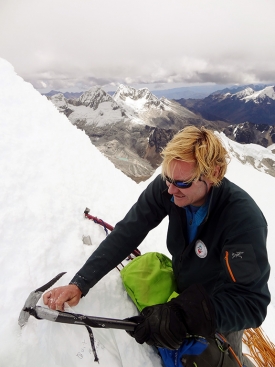Measuring pollutants on Andean glaciers
Feb 4, 2013 - by Staff
Feb 4, 2013 - by Staff
February 4, 2013 | For the millions of people in Peru and neighboring countries who depend on glacier runoff for water supply, their future may depend in part on the color of the ice high in the Andes Mountains.
Glaciers in the South American high country have retreated dramatically in the past several decades, sparking concerns about the eventual loss of water that is needed for drinking, hydropower, and agriculture. As scientists try to project future runoff, one question they must answer is the extent to which the white ice of the glaciers is being darkened by particles emitted by nearby industrial activities. These dark particles can dramatically accelerate the melting because they absorb solar heat and amplify the warming, unlike the natural white ice surface that reflects solar heat back into space.
NCAR scientist Carl Schmitt, an expert in cirrus clouds and their role in the climate system, is taking this line of inquiry to a rarified level. For the past two years, he and other volunteers with the American Climber Science Program have ascended above 20,000 feet to gather ice samples in Huascarán National Park in Peru, which contains the world’s largest expanse of tropical glaciers.
An avid mountaineer, Schmitt is conducting the science on a volunteer basis, using his scientific skills to try to determine if certain glacial regions are being particularly affected by increased levels of pollution.

John All, director of the American Alpine Club's American Climber Science Program and associate professor of geography at Western Kentucky University, takes a snow sample in the Cordillera Blanca range of the Peruvian Andes. All and other researchers, including NCAR's Carl Schmitt, are assessing the impact of ash and other particulates on Andean glaciers. (Photo by Ed Laughton, courtesy Western Kentucky University.)
Schmitt and the other volunteers brought the samples back to base camp, where they were rapidly melted and run through 0.7-micron filters that captured the particulates. Preliminary results indicate that ice close to Huaraz, a rapidly growing Peruvian town with nearby mining operations, contained such a high level of particulates that the filters turned almost entirely black. In contrast, ice in a remote region about 50 miles further from the town was so clean that the filters hardly captured any particulates at all.
When Schmitt used applied infrared heat on the filter samples, the particulates from the dirtier ice heated up 20-30 degrees Celsius within 10 seconds. In contrast, the more pristine ice filters did not heat up at all.
“It doesn’t take a lot of absorptive material in glacier ice to cause it to melt a fair amount faster,” Schmitt says.
He presented these results at the annual conference of the American Geophysical Union in December.
Schmitt and other volunteers are hoping to get funding for the next phase of the project. This will include further analyzing the samples, currently stored in a special freezer, to learn more about the origin and chemical composition of the particulates. Among other issues, this will shed light on which types of particulates are especially responsible for accelerated melt. They are also planning a third expedition to the region in 2013.